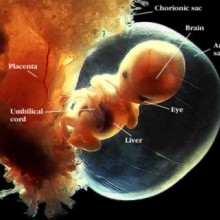Given that a foetus is essentially a swimming thing on the end of a piece of string, how is it that the two don't become tangled more often? Find out in this jelly-like QotW. Plus, we ask what would happen if two black holes met.
In this episode

00:00 - Do umbilical cords get tangled and knotted?
Do umbilical cords get tangled and knotted?
Christoph - My name is Christoph Lees. I'm a Consultant in Obstetrics and Foetal Medicine at the Rosie in Addenbrookes at Cambridge. It's a really interesting question and a lot of women do ask us this specific question. The umbilical cord is about 30 to 60 cm in length at term. So at 36, 37 weeks it really is quite long. The important thing about it is, not only is it long, but it's really thick. So it's up to 2, sometimes 2 Ã?,½ cm thick, and not only does it contain two arteries and one vein. But it also contains a lot of jelly-like substance called Wharton's Jelly that protects the blood vessels. So it really is encased in quite a thick covering and then the blood vessels have jelly around them. So that stops them getting twisted or occluded in any way. Now sometimes you can have a knot in the umbilical cord, so babies obviously move around. They jump up and down, they turn over from head down to bottom down sometimes. Why doesn't that cause the umbilical cord to knot? Well the answer is that sometimes it does, but it's very rare in fact, for a knot to cause a problem for a baby. So, because the umbilical cord is so thick, it tends not to knot itself easily and even if it does knot itself, there is so much protective jelly around the blood vessels that it's very rare that it causes a problem.
Diana - Umbilical knots do happen occasionally when a foetus swims through a loop in the cord, but the structure of the cord makes it difficult for this to have any adverse effects. There has to be a great deal of tension in order for the knot to compress the cord with any significance, and therefore, impede blood flow. CliffordK on the forum found us an article from Paediatric and Prenatal Pathology Associate in Louisville in the US. And they estimated that around 3% of preterm still births occur due to cord knots.









Comments
Add a comment